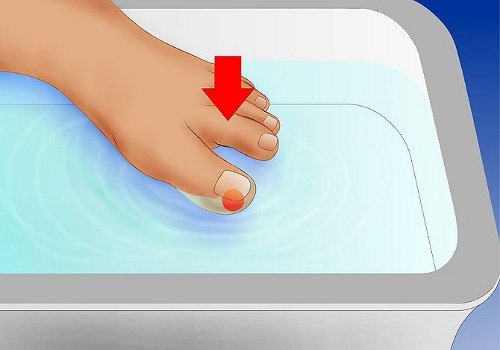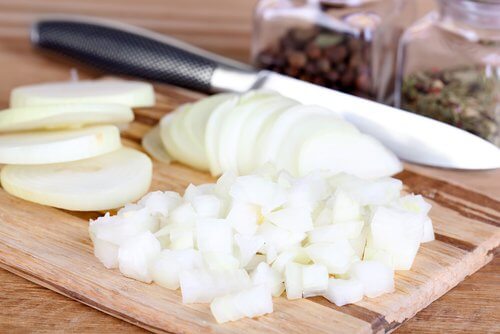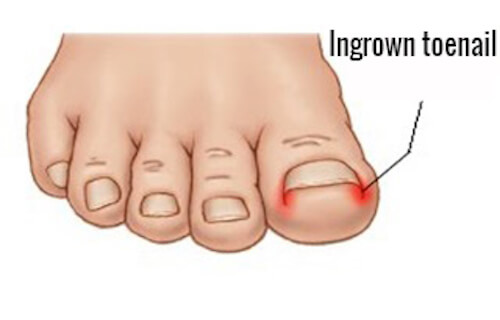How To Treat Ingrown Toenails Correctly


Reviewed and approved by the doctor Karla Henríquez
Onychocryptosis is the technical term for what we know as “ingrown toenails”. This problem tends to being very painful and quite unpleasant, and mainly affects the big toenail, causing swelling and, in most cases, infection. In today’s article we’ll find out how to treat ingrown toenails correctly.
It’s very important to treat ingrown toenails correctly so that they don’t turn into a more serious problem. That’s why we’ve put together the following article detailing the entire treatment process for ingrown nails, as well as a few tips to alleviate the pain caused by this problem.
Steps to treat ingrown toenails correctly
- First of all, you should look for a large bowl to be able to soak your feet in hot water for about 15 or 20 minutes. This part of the treatment is aimed at alleviating pain and, above all, preventing possible infection in the affected area. You can use a bit of anti-bacterial soap for better results.
- After about 20 minutes, dry off your feet and slide a string of floss under the nail. You should perform this treatment on a regular basis. Make sure you change the floss each day so that the nail can grow above the skin.
- Cut your nails with a straight nail clipper and file them to a square shape without any kind of border. Try not to cut your nails in a round shape, because this increases your risk of ingrown toenails.
- Use a local antibiotic for immediate pain relief. You can get gels, creams and similar ointments at the drug store.
- As you continue treating your ingrown nail, you should do your best to use open footwear that doesn’t rub against the affected area, thereby causing greater damage. Avoid using tights or closed shoes.
Read more: How to Naturally Cure Ingrown Toenails
Homemade remedies for alleviating ingrown toenails

In addition to the previous steps to treat ingrown toenails correctly, you could also consider trying some of the following home remedies that should help you speed up the recovery process.
- Onion juice
Firstly, squeeze the juice from one onion and apply it directly to the injured toenail. Let the juice dry on the nail, and perform this treatment on a regular basis for best results. - Saltwater
Prepare a saltwater solution and then apply it directly to the affected area every night before bed. Wrap your toe after applying the remedy and let it set until the next day. - Lemon
Rub a lemon slice directly on the affected area and use a wrap or some gauze to attach it to the nail for a few hours. - Garlic
Garlic is known to be a very powerful natural antibiotic which can help you fight off infection (in this case, under the nail) and reduce the swelling caused by ingrown toenails. Crush a bit of garlic and then apply it directly to the affected area. - Tea tree oil
This essential oil acts as a natural antibiotic, which can help you fight off infection. Apply a few drops of tea tree oil directly to the affected area. - Carrot
Firstly, wash and mash one carrot until a paste is formed, and apply it directly to the affected area. Then cover with a wrap and let it sit for a few hours. Repeat this remedy twice per day.
See also: Tea Tree Oil: the Amazing Oil that Provides Many Benefits
Other recommendations

- If the pain is unbearable, then you should see a doctor to prescribe a painkiller.
- If you suffer from diabetes, you should make sure to have a doctor supervise any treatment involving an ingrown toenail.
- When you’re at home, try to walk around barefoot. This will allow your nail to get plenty of air circulation, which will then keep bacteria from growing in the affected area. Keep in mind that bacteria reproduce more quickly in hot, humid environments, so try to avoid closed shoes at all costs.
- Try not to use high heel shoes or any kind of uncomfortable footwear. Looking great in an elegant pair of shoes won’t do you any good if it means suffering intense pain once you get home. You should never force your feet into a tight, painful shoe.
- Remember that nail hygiene is crucial to preventing ingrown toenails. It’s important to check the state of your nails on a regular basis, cleaning and cutting them correctly. Follow the above-mentioned tips to keep this problem from occurring again.
All cited sources were thoroughly reviewed by our team to ensure their quality, reliability, currency, and validity. The bibliography of this article was considered reliable and of academic or scientific accuracy.
- Heidelbaugh, J. J., & Lee, H. (2009). Management of the ingrown toenail. American Family Physician. https://doi.org/10.1016/j.jmathb.2017.08.004
-
Bryant, A., & Knox, A. (2015). Ingrown toenails: The role of the GP. Australian Family Physician.
This text is provided for informational purposes only and does not replace consultation with a professional. If in doubt, consult your specialist.








